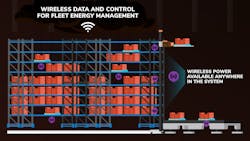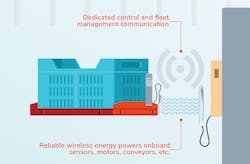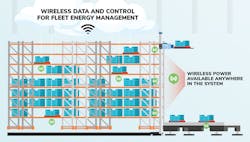Members can download this article in PDF format.
What you’ll learn:
- How e-commerce order processing has evolved from mobile robots to 3D automated storage and retrieval systems.
- The challenges faced by fulfillment centers in powering these robots.
- How wireless charging systems can be optimized to meet these needs.
As e-commerce companies race to deliver products more quickly while driving down costs, they’re exploring new warehouse configurations that rely heavily on complex connected networks of robots.
These robots venture meters deep inside vast racks of densely packed products where humans can't reach. However, that's only possible if operators can get them the electricity they need. Here's how specialists are optimizing wireless-charging solutions to power robots as they tunnel into warehouse storage.
The Explosion and Evolution of E-commerce
Warehouse management has experienced a major upheaval in the last few years, thanks to the emergence of e-commerce. According to the U.S. Census Bureau, U.S. revenue in this sector rose steadily from $5B when measurements began in 1998, to $571.2B in 2019. The pandemic accelerated its growth dramatically, rising almost 43% from 571.2B to $815.4B from 2019 to 2020. That trend has continued, with e-commerce revenues set to top $1 trillion in 2023.
This boom has created a rising tide of everything from sourdough starter sets to water filters and Apple AirTags. It’s placing new pressures on the fulfillment centers that sort and ship those products. They must find a way to process more items, ideally without expanding floor space to drive up costs.
Other factors make meeting that demand more difficult than ever. Customers want faster delivery, forcing fulfillment centers closer to dense urban conurbations where real estate availability is lowest and the cost per square foot is the highest.
A labor shortage also leaves fulfillment centers struggling to pick and pack orders quickly enough. Inflation multiplies the hiring investments that companies must make to overcome these challenges.
Pursuing More Efficient Fulfillment Centers
Fulfillment centers were exploring automation to make existing staff more productive long before the pandemic. They have been using robotics for over a decade, particularly in e-commerce warehouses, to retrieve products more efficiently.
These autonomous mobile robots (AMRs) reduced the time that employees spend walking around the warehouse. They enabled human operators to remain stationary while mobile robots shuttled entire racks of products to them for order picking.
Such robots were more effective than manual retrieval, but still suffered from a drawback: The racks they carried were limited in height. Anything more than a six-foot rack might tip over. In a typical warehouse that can reach up to four stories high, it left a lot of unused space that required heating and cooling without any return on investment per cubic foot.
More recent automated storage and retrieval systems (AS/RS) are solving this problem. Some innovative e-commerce players have experimented with stacked racks in a static configuration, a little like the vertical-lift automated retrieval systems seen in some libraries, but far more sophisticated.
These 3D AS/RS solutions stack pods of products atop each other dozens of feet high. Instead of moving around the warehouse floor, a robotic shuttle travels vertically to the level where a pod is located, and then horizontally along and through the racks to reach it. It then pulls the pod and travels back through the system, delivering it to the human operator for picking before returning it.
Delivering Power to 3D AS/RS
These 3D AS/RS systems offer irresistible benefits. By increasing product density in warehouses, they make better use of the space. They also boost worker productivity and increase order accuracy. However, they also present a unique challenge—delivering power to the fast-moving shuttles.
There are dozens of robotic shuttles in a large 3D AS/RS system. The length and complexity of their paths make it impossible to propel them on their way with wired connections. This leaves one of four propulsion power-delivery options: batteries, supercapacitors, electromagnetics, or direct energy delivery from the track/rail to the shuttle via contact points.
Battery technology uses lithium-ion chemistry to store large amounts of energy to supply quick bursts of propulsion. A battery can provide enough power to sustain a shuttle for hours. Their downside is maintenance. With so many charge cycles, batteries wear out quickly and regularly need replacing. It’s a complex process in a 3D rack-based system, leading to extended downtime.
Another disadvantage is that shuttles must stay stationary for extended periods while they recharge. That increases the number of shuttles necessary for constant system operation at full capacity.
An alternative energy-storage option is the supercapacitor, which operates like a short-term battery but has a far longer lifespan. The downside is that it must be recharged very frequently and at high current (amps). There’s also less control over energy discharge when driving multiple functions on the shuttle.
In both of the above alternatives, a physical connection must also be made between the rack and shuttle to transfer energy to the storage device. With potentially thousands of charge cycles per day, any power-delivery mechanism requiring physical contact will lead to increased maintenance, failures, and downtime.
Electromagnetic propulsion systems do away with on-board power storage altogether, but only for propulsion. They instead use a combination of permanent magnets on the shuttle, along with track-based electromagnets that can be toggled on and off to drive the shuttle along its track. This propels the shuttle itself but doesn’t deliver electricity for onboard devices.
Meeting On-Shuttle Power Needs with Wireless Delivery
While electromagnetic propulsion reduces the need for power in 3D AS/RS shuttles, it doesn’t eliminate it altogether. The shuttles still require on-board power for sensors, to open doors or run conveyors, or for actuators that retrieve bins from within the racks.
Wireless power systems can provide this power opportunistically while the shuttles are paused at a destination such as a bin, or a human pick-and-pack point. This can either keep the battery charged or delivery power instantaneous to operate various devices.
While power could be delivered to the shuttle via contact mechanisms such as brushes or a spring-loaded pin, this approach inherently introduces wear and tear. Dust, moisture, and corrosion also degrade the contacts, affecting power distribution and reducing the power-delivery system's mean time between failure (MTBF).
Wireless charging is an alternative delivery option that’s entirely contact-free. It uses two sealed coils that align in close proximity. One coil creates an oscillating electromagnetic field that induces a current in the second coil, enabling it to feed an energy-storage mechanism or directly power on-device electronics.
The Limitation of Inductive Wireless Charging
Inductive charging, typically seen in consumer applications like mobile-phone charging, radiates the electromagnetic field in all directions from the transmitting (Tx) coil. Radiant charging causes the magnetic field flux to drop rapidly as the two coils move apart, shortening the effective coupling distance between them. Consequently, inductive charging requires tight alignment and close proximity with the receiving (Rx) coil.
This coupling distance is a problem in 3D AS/RS environments for several reasons. These systems move quickly over dozens of meters. Even the tightly honed travel mechanisms they use can’t guarantee that they will come to rest at precisely the same spot. In turn, it becomes difficult to predict the coupling efficiency of purely inductive wireless power delivery.
Resonant Charging to the Rescue
Another wireless-charging approach, resonant wireless power, solves the problems of inductive charging by introducing identical resonant frequencies between the two coils. Some inductive charging also naturally occurs as the two coils come closer together in a resonant system. Nevertheless, resonance charging doesn’t depend as much on proximity and orientation as does inductive charging.
The result is a far more forgiving coupling mechanism than purely inductive techniques. Resonant charging can transfer power effectively and more efficiently over longer distances. It can also sustain that charge even when the two coils aren’t perfectly aligned.
Another benefit of a properly designed resonant-charging system is reaction speed. AS/RS shuttles typically stop for only a few seconds to load and unload payloads or to recharge for very brief yet frequent intervals. This means the system must turn on and off quickly as various loads are introduced and then suddenly removed.
For instance, the electrical load of a conveyor belt or motor controller typically draws high current during initial startup and can then fluctuate rapidly. Historically, this has been a challenge for wireless power systems because rapid power changes cause instability in the transmitter’s power-amplifier circuitry. Resonant systems, with their increased range and stability, minimize these negative effects regardless of load type and/or coil position.
Optimizing Resonant-Charging Design
Resonant charging also permits more design innovations in the coupling electronics and software to solve other problems. One of these problems is frequency variance. The transmission and reception coils must resonate at the same frequency for optimal charge transmission.
Resonance relies on impedance (the frequency-based resistance to current flow). Sustained resonance means maintaining the same impedance level in the Tx and Rx units.
Various factors can affect impedance and its dependent resonant frequencies. One is electromagnetic interference in the operating band. Whereas most inductive systems use lower frequencies in the 80- to 200-kHz range, resonant systems often use the 6.78-MHz shortwave ISM band reserved for industrial and other purposes. This unregulated part of the spectrum can experience electromagnetic interference (EMI) from other equipment in the same band.
Another problem is that 3D AS/RS environments are tightly constrained with many moving parts. Large sheets of metal inside the multi-story racks can shift the frequency of the electromagnetic signals used by the shuttle and the charging station.
Moreover, shuttles that stop short may cause impedance-matching problems, as do different voltage and current levels used across different equipment. Even the temperature of the internal components on the Tx and Rx units can affect impedance and resonance.
Combined Hardware/Software Approach to Dynamic Impedance Matching
All of the above variables create volatile conditions in which impedance can change not only between charge cycles, but even within the same charge cycle. A dynamic impedance-matching system can support impedance change across multiple equipment pairs with different load characteristics.
Using data from multiple transmitter and receiver sensors and an advanced state machine, adjustments are able to be made in software at the device level to optimize impedance matching in real-time. However, such rapid response requires low-latency communications between the Tx and Rx units.
A proprietary 2.4-GHz RF communication system offers less latency than Bluetooth and more reliability than Wi-Fi for communications between the Tx and Rx units. This enables them to maintain the impedance match dynamically and quickly in response to changing conditions.
Low-latency communication is especially helpful when the system is acting as a power supply rather than a battery charger. With battery charging, it’s acceptable (and preferable) to begin charging at a low current, quickly ramping to the full power within several seconds.
When acting as a power supply, however, the wireless power system must often deliver full current immediately—for instance, to start a motor. Designing a system that can operate in either battery-charging or power-supply mode is complex and, again, requires both rapid radio response and an advanced state-machine algorithm.
Fast-moving shuttles also depart and break the wireless-charging link very quickly when the battery is fully charged or if the shuttle must leave to complete a new task. This challenges the system even further, since energy could be reflected back into the Tx unit and damage its electronics. The low-latency system solves this problem by quickly stopping power transfer as the shuttle moves away.
Whole-System Optimization
These shuttles and charging points don’t exist in isolation; they’re part of a complex mesh of dense machinery. It’s crucial for operators to maintain a clear picture of overall system health.
The control radio system also logs the performance of every Tx and Rx in the system and communicates it back to a central management point. Power-system software can provide valuable information directly to the user, or fleet-management software programs could access the charging system data via APIs. In systems that use battery-powered shuttles, it can record how each shuttle's batteries are performing over time. All of this data is useful for predictive and preventative maintenance.
The data network also allows for constant whole-system optimization by identifying patterns in shuttle behavior. It can collect data on the optimal position for shuttle power delivery, which is especially important for battery-powered units that must take longer to collect a suitable charge.
Heading Toward a Denser, More Efficient Future
Electrical designs like these might seem niche, but they have significant commercial ramifications. E-commerce warehouse operations running flat out to accommodate growing demand are increasingly looking for 24x7 operating capacity with minimal downtime.
More strategically still, better-powered 3D AS/RS systems enable e-commerce companies to enhance the placement and configuration of these warehouses, expanding from large suburban or rural locations to micro-fulfillment centers. The race is on to shorten delivery times, which means locating warehouses as close as possible to the most customers. That typically requires positioning them in cities, where commercial real estate lies on smaller lots and is expensive to rent.
Building up rather than out gives micro-fulfillment operators better ROI. Creating efficient 3D AS/RS systems that stretch stories high enables e-commerce companies to reconfigure smaller, taller buildings for warehousing operations, opening up new opportunities for efficiency.
As e-commerce front-runners begin benefiting from the power of 3D AS/RS, second- and third-tier players will rush to invest in these promising solutions. As they do, wireless power delivery will be key to ensure that the flow of electrons matches the pace of e-commerce innovation.
About the Author
Matt Carlson
VP of Business Development, WiBotic
Matt Carlson has worked in technology startups for over 20 years, having held senior management positions in sales, marketing, product management, and business development. He’s currently the Vice President of Business Development at WiBotic Inc., a company that provides reliable wireless power solutions to charge aerial, mobile, and aquatic robot systems.


